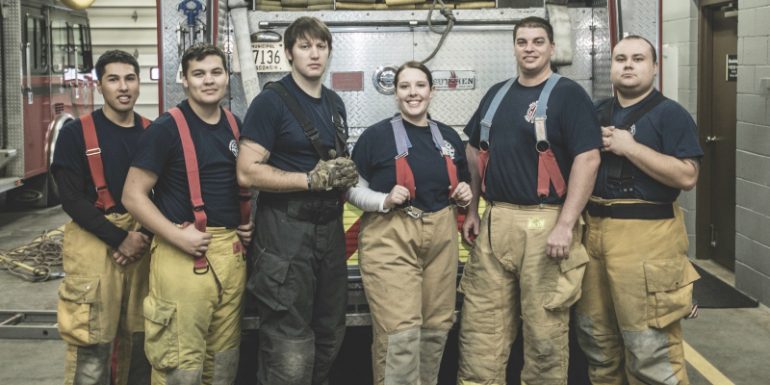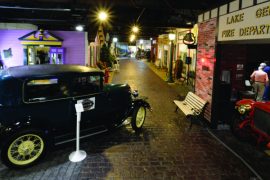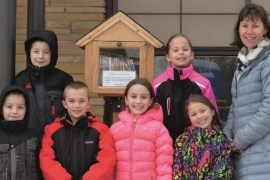Photography and Story by Holly Leitner
It’s a brisk morning in Kansasville, Wisconsin. A thin frost dusts the ground, a winter wind funnels through the open land and a large sign reads, “Looking for Volunteer Firefighters and EMTs.”
I’m at the Kansasville Fire House, on the western edge of Racine County. This hub also doubles as the hands-on school for Gateway Technical College’s Firefighter 1 class, the required course for all state- certified career and volunteer firefighters.
The students here today are just two classes and two exams shy of completing the 96-hour course. They come from Kenosha, Racine and Walworth counties and include a high school senior, a full-time physician and other aspiring firefighters from all walks of life.
According to John Dahms, Gateway’s Fire Program Coordinator, roughly 150 people complete the class each year— 60 percent of those are pursuing a career in firefighting and 40 percent are becoming volunteers for community fire departments.
One such student on the volunteer track is Dr. Sean Marquis, EMS physician and associate EMS medical director for Mercyhealth. In order to complete the course, he has crawled through blazes that reach 1,000 degrees Fahrenheit, climbed three stories with equipment on his back, while carrying a 16-foot-ladder, and spent many hours studying fire science and hazardous materials operations.
“I’ve always felt a sense of duty to respond when people are in need,” says Marquis. “It’s been an important goal of mine to join the front lines of fire service since my college days, and technical rescue has been a part of my professional EMS career all along.”
Marquis approached the Fontana Fire Department last year about joining their ranks and he’s been a probationary member for the past 11 months, a trial period that all new recruits must complete. After this certification he will join the nearly 100 percent volunteer, 25-person crew in Fontana comprised of a local construction worker, boat mechanic, industrial kitchen cook, bartender, nurse, police officer, public works employee and financial consultants, among others.
THE VOLUNTEER FIREFIGHTING TRADITION
Volunteer firefighting is a tradition, whose history dates back generations. From the earliest colonial days, it was a common practice that all able-bodied adults would come together to fight fires that threatened their towns by filling buckets from a water source and passing them along a line of volunteers to the fire. These groups grew into “Fire Clubs” and later, The Union Fire Company of Philadelphia formed by Benjamin Franklin in 1736.
Today, nearly 70 percent of the fire departments in the country are still led by volunteers, according to the National Fire Council. In rural Walworth County there are roughly 15 fire departments. Only one is staffed with full-time, paid personnel available around the clock; the remaining departments are run by volunteers. Some towns have been forced to turn to paid personnel simply because they lack the volunteer base that once was available.
“Society is changing as a whole — it takes two bread winners to make a house run today. People just don’t volunteer much anymore,” says Fire Chief Wolfgang Nitsch of the Fontana Fire Department. “Other civic organizations are saying the same thing, there’s just not a lot of time, everybody is just busier in general.”
Fire Chief Nitsch started with the departmentin1978, and during that time, he’s described the participation as being up and down, but generally down since the ‘90s. Today, the Fontana Department is staffed by two full-time paid personnel and supplemental, paid on-call staff.
Jack Jasperson, the full-time faculty lead for the Firefighter 1 class, agrees that the biggest challenge of fire departments around the country is finding volunteers, and that’s partially due to changing communities. “There used to be a nucleus of people in a community, many that owned businesses, and everybody could leave work to help the town,” says Jasperson. “It’s kind of changed with the loss of brick and mortar stores. Daytime availability is gone.”
If it’s not a longer commute or business travel to contend with, it’s family commitments like running kids to extracurricular activities and taking care of elderly parents. For most people there is so little unscheduled time for volunteering for causes like hometown fire departments, making it less a priority than it used to be.
In addition, firefighting takes an incredible amount of courage. It’s demanding, dangerous and unpredictable. With every call, the firefighter puts himself in harm’s way to help those in need. All while balancing the demands of their daily jobs.
So … why do it? For some, like Marquis, there is still a sense of civic duty to give back to their community. “It gets back to helping neighbors, being of service and reconnecting with your community. It’s about those moments when time stands still — and the moments you can define your life by. Imagine being able to say, ‘I helped saved their son, the family dog or the priceless family heirloom from turning to ashes.’ It’s at these moments where life comes clearly into focus when so much of our time is taken by unessential distractions.”
“Fire service is its own community, a noble one with dedicated people,” adds Marquis. “The level of teamwork and trust required in it is unlike most other organizations.”
HOW TO VOLUNTEER
If you’re interested in volunteering, the best place to start is to visit your local fire department. First, there are varying degrees of volunteering. Fire departments have adapted to the changing society — offering different options of service. One can choose to be on the second or third string of calls with varying degrees of commitment. Local first responder teams are looking for EMTs, rescue divers, non-responding fire corps, volunteers and youth fire explorers.
“Our doors are always open,” says Delavan Fire Chief Tim O’Neill. “We’re eager to accept. You just have to live within the response area and go through the training.” The Delavan department, like other departments, will pick up the cost of training for any firefighter.
All firefighters must go through a Firefighter 1 class, such as the one taught at Gateway Technical College, within the first year on the department in order to enter live fires. This class covers hands- on training, preparation for certifications and assistance with locating volunteer opportunities, and is taught by currently employed, certified staff. In addition, most departments require attendance at monthly meetings.





